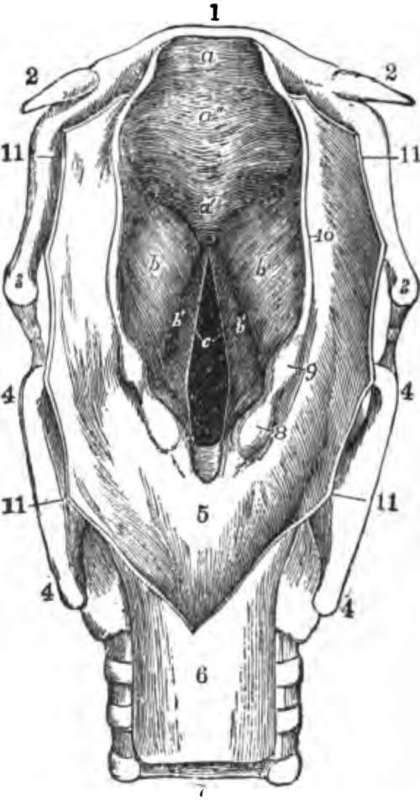The Vocal Cords
Description
This section is from the book "The Human Body: An Elementary Text-Book Of Anatomy, Physiology, And Hygiene", by H. Newell Martin. Also available from Amazon: The Human Body.
The Vocal Cords
The Vocal Cords, which are rather projecting pads of elastic tissue than cords in the ordinary sense of the word, proceed, one from each arytenoid cartilage behind, to the angle where the halves of the thyroid meet in front. In quiet breathing the interval (glottis) between them (c, Fig. 98) is narrow in front and wider behind: under such circumstances air driven through the opening does not set the margins of the cords in vibration, and no sound is produced.
Describe the position and form of the thyroid cartilage. What causes "Adam's apple"? What is the epiglottis? How may you see it in your own throat? Describe the cricoid cartilage. What cartilages are set on top of the cricoid ? What is their form?
Between what points are the vocal cords stretched? Under what circumstances does air driven through the glottis not set them vibrating?
The Muscles Of The Larynx
The laryngeal muscles are numerous, and are arranged—(1) to pull the arytenoid cartilages towards one another and so narrow the glottis behind; then air forced through the narrowed slit sets the cords vibrating and produces voice. (2) To increase the distance between the arytenoid cartilages behind and the thyroid in front: as the vocal cords are attached to both, this action stretches and tightens them, and so raises the pitch of the voice. (3) To pull the front of the thyroid cartilage nearer the arytenoids and so slacken the cords and lower the pitch of the voice. (4) To separate the arytenoid cartilages, and with them the vocal cords, and thus widen the glottis and allow air to pass through it without producing voice.

Fig. 98. The larynx viewed from its pharyngeal opening. The back wall of the pharynx has been divided and its edges (11) turned aside. 1, body of hyoid; 2, its small, and 3, its great, horns; 4, upper and lower horns of thyroid cartilage; 5, mucous membrane of front of pharynx, covering the back of the cricoid cartilage; 6, upper end of gullet; 7, windpipe, lying in front of the gullet: 8, eminence caused by cartilage of Santorini; 9, eminence caused by cartilage of Wrisberg; both lie in, 10, the aryteno-epiglottidean fold of mucous membrane, surrounding the opening (aditus laryngis) from pharynx to larynx, a, projecting tip of epiglottis; c, the glottis, the lines leading from the letter-point to the free vibrating edges of the vocal cords. b', the ventricles of the larynx: their upper edges, marking them off from the eminences b, are the false vocal cords.
Continue to:
